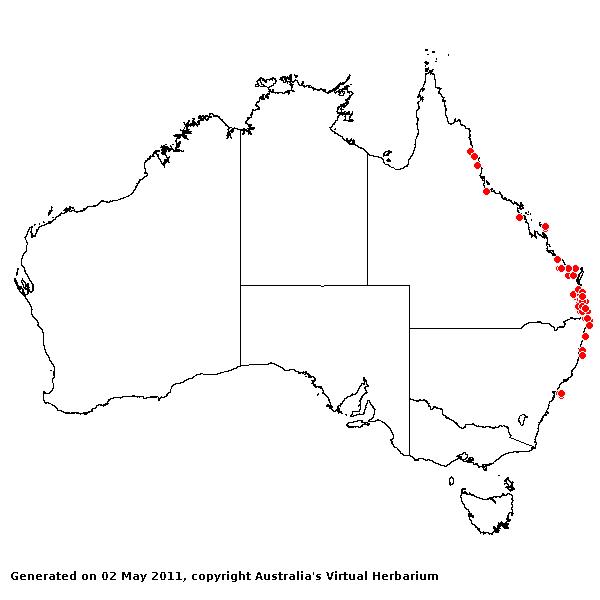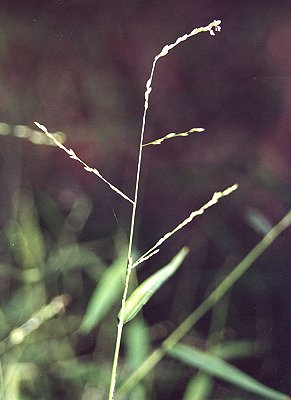Ottochloa gracillima C.E.Hubb. Bull.
Misc. Inform. 445 (1934).
Classification. (GPWG 2001) : Subfamily
Panicoideae. Paniceae.
Type of Basionym or
Protologue Information: HT: C.E. Hubbard 8600, 3 Apr 1931,
Australia: Queensland: Moreton District: Mogill (K; IT: BRI, CANB, MEL,
US-1721123).
Key references
(books and floras): [2002] D.Sharp & B.K.Simon, AusGrass, Grasses of
Australia, [2008] S.W.L.Jacobs, R.D.B.Walley & D.J.B.Wheeler, Grasses
of New South Wales (311).
Illustrations:
[1984] N.T.Burbidge. rev. S.W.L.Jacobs, Australian Grasses (195), [2008] S.W.L.Jacobs, R.D.B.Whalley
& D.J.B.Wheeler, Grasses of New South Wales, 4th edn (311).
Habit.
Perennial. Culms sprawling, stature slender to delicate, 5–60 cm tall. Mid-culm
internodes glabrous or with pubescent line. Leaf-sheaths glabrous on surface or
hairy. Ligule an eciliate membrane, 0.1–0.3 mm long. Leaf-blades linear or
lanceolate, 1–10 cm long, 1.5–7 mm wide.
Inflorescence.
Inflorescence compound, a panicle. Racemes 2–4, 0.5–2 cm long. Central
inflorescence axis 1–9 cm long.
Spikelets.
Spikelets pedicelled. Fertile spikelets 2-flowered, the lower floret barren
(rarely male), the upper fertile, comprising 1 basal sterile florets,
comprising 1 fertile floret(s), without rachilla extension, oblong, dorsally
compressed, 1.7–2.3 mm long.
Glumes. Glumes
similar, thinner than fertile lemma. Lower glume ovate, membranous, without
keels, 3 -nerved. Upper glume elliptic or ovate, 1–1.2 mm long, membranous,
without keels, 3–5 -nerved. Florets. Basal sterile florets 1, barren,
without significant palea. Lemma of lower sterile floret 100 % of length of
spikelet, membranous, 7 -nerved.
Fertile lemma 1.7–2.3
mm long, without keel, 3 -nerved. Palea 2 -nerved. Anthers 3.
Continental
Distribution: Australasia.
Australian
Distribution: Queensland, New South Wales.
Queensland:
Cook, Moreton, Port Curtis, South Kennedy, Wide Bay. New South Wales:
North Coast, Central Coast.
Notes.
Distinguished from O. nodosa by spikelet length. This species is very
variable anatomically and there are reservations as to whether it forms a
species distinct from O. nodosa. The only differences are in degree of
size.
Qld and N.S.W. A
sprawling, weak grass occurring sporadically in tropical and subtropical
woodlands. Flowers Jan.-May.



